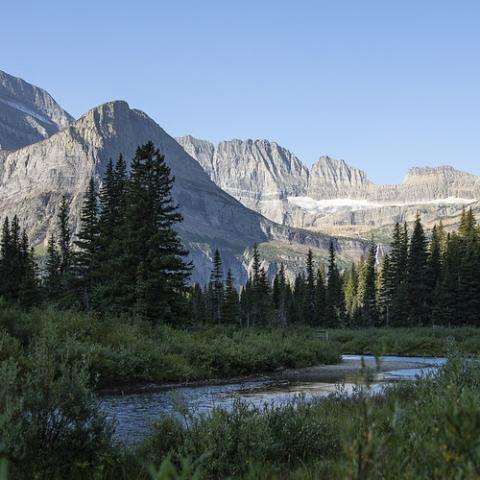
Trapping of grizzly bears will be going on in Glacier National Park so biologists can fit radio collars to the bears/NPS file photo
Bear research in Glacier National Park in Montana has wildlife biologists trapping some grizzlies to fit them with radio collars for ongoing research into the bruins' habits in the park and to get a population estimate.
Bait stations, automated cameras, and traps are used to capture and mark the animals. There are an estimated 300 grizzly bears living in Glacier. The park’s goal is to maintain a sample of up to 10 radio-marked female grizzly bears for this monitoring effort. This year, some bears may receive a collar for the first time. Others may have a collar replaced if it is near the end of its useful lifespan.
Brightly colored warning signs identify bait stations and trap sites. Visitors are required to heed these signs and not enter closed areas. In 2010, a man was killed by a grizzly bear seven miles east of Yellowstone National Park after wandering into a capture site. Trapping efforts will continue May 15 through October at various locations throughout the park.
“Glacier National Park is bear country, and park visitors should be prepared for bear sightings, in addition to following other hiking safety precautions,” said Glacier Superintendent Jeff Mow.
Park visitors should travel in groups and make loud noises by calling out or clapping their hands at frequent intervals, especially near streams, and at blind spots on trails. These actions help avoid surprise bear encounters. Do not approach any wildlife; instead, use binoculars, telescopes, or telephoto lenses to get a closer look. Visitors should maintain a minimum distance of 100 yards from any bear within the park.
While carrying firearms within national parks and wildlife refuges is permitted as consistent with state laws, proper use of bear spray has proven to be the best method for fending off threatening and attacking bears, and for preventing injury to the person and animal involved. Wounding a bear, even with a large caliber firearm, can put you and others in far greater danger.
Anyone participating in recreational activities in bear country is highly encouraged to have bear spray. The bear spray should be readily accessible, and hikers should know how to use it.
Visitors should store food, garbage and other attractants in hard-sided vehicles or bear-proof food storage boxes when not in use. Garbage must be deposited into a bear-resistant trash can or dumpster. These actions help keep bears from becoming conditioned to human food, and help keep park visitors and their personal property safe.
Visitors should report any bear sightings or signs of bear activity to the nearest visitor center, ranger station or by calling 406-888-7800 as soon as possible.
In addition to bear safety precautions, hikers in Glacier National Park should review other safety measures to take when exploring park trails. To help plan day hiking trips in the park, Glacier offers a Day Trip Plan to help visitors prepare for their hike. Before departure, it is vital to tell someone where in the park you are going, and how long you expect to be gone. Visitors should carry the ten essentials, including a map of the area, a compass, a flashlight, extra food, extra clothing, sunglasses and sunscreen, a pocketknife, matches in a waterproof container, a candle or other fire starter, and a first aid kit. Visitors should also carry bear spray and be prepared for suddenly changing weather events.




 Support Essential Coverage of Essential Places
Support Essential Coverage of Essential Places






